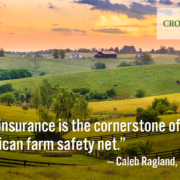Slicing crop insurance cuts at America’s Heartland
It’s been a wet spring around my family’s farm. We’re about three weeks behind on planting and, like many of my neighbors in Magnolia, we’re hoping for continued warm weather.
I love this time of the year. This is what it’s all about for a farmer — putting a seed in the ground and raising it all season for harvest.
My family has been doing just that in this part of Kentucky for nine generations. At 31, I’m already a lifer. There’s nothing I’d rather be doing than growing soybeans, corn and winter wheat and raising pigs in a pretty part of the world.
But, lately, the business of farming has been tough. I’m not the only one feeling the pressure. Nationally, farm incomes are down 50 percent compared to what they were five years ago. That’s put a pinch on everyone.
Grain prices are down. So are beef, pork, poultry and milk. Couple all that with the fact that most of your farmland operations, on any scale, have substantial debt loads, and it’s easy to see how people are struggling in farm country.
On the upside, we have a growing global population and I think the future is bright — especially if smart policy decisions are made in Washington. Congress currently is debating the Farm Bill, which is critical to how we plan and run our business.
Crop insurance, which is part of the Farm Bill, has become the main way farms mitigate the risks of uncontrollable weather and unpredictable price swings. It has become the cornerstone of the American farm safety net.
Crop insurance is a lot like life insurance. You don’t ever want to use it. But at the same time, it helps manage through a disaster and helps you stay in business.
The last time we used crop insurance was the drought of 2012. Without it, we would have had a hard time planting our next crop.
Most banks require it nowadays to get an operating loan at the start of the season.
Crop insurance has changed a lot in recent years — offering dozens of policies and coverage options that are as unique as America’s farms. This ability to tailor coverage to fit your individual need and adapt to a changing market is one reason crop insurance has become so popular.
Products such as Harvest Price Option give us modern tools to manage the risks of modern agriculture.
HPO lets us forward market our crops. It protects revenue, not just yields, offering the equivalent of “replacement value” coverage on a car.
As farmers, we’re willing to pay extra for the protection HPO offers because it gives you the faith you need to put your borrowed money in the ground and know you’ll be able to pay it back.
I hope Congress will leave crop insurance alone in the Farm Bill.
Without this essential risk-management tool, a lot of farmers are going to be left holding the bag. Without it, it is going to be hard to incentivize folks to put out crops and produce the food and fiber we need to feed and clothe the country.
Cutting crop insurance would be like cutting the heart out of the heartland. That’s not just bad for farming; that’s bad for everyone.
Caleb Ragland grows soybean, corn, winter wheat and raises pigs with his father and grandfather at Shady Rest Farm in Magnolia. He can be reached at shadyrest08@gmail.com.

